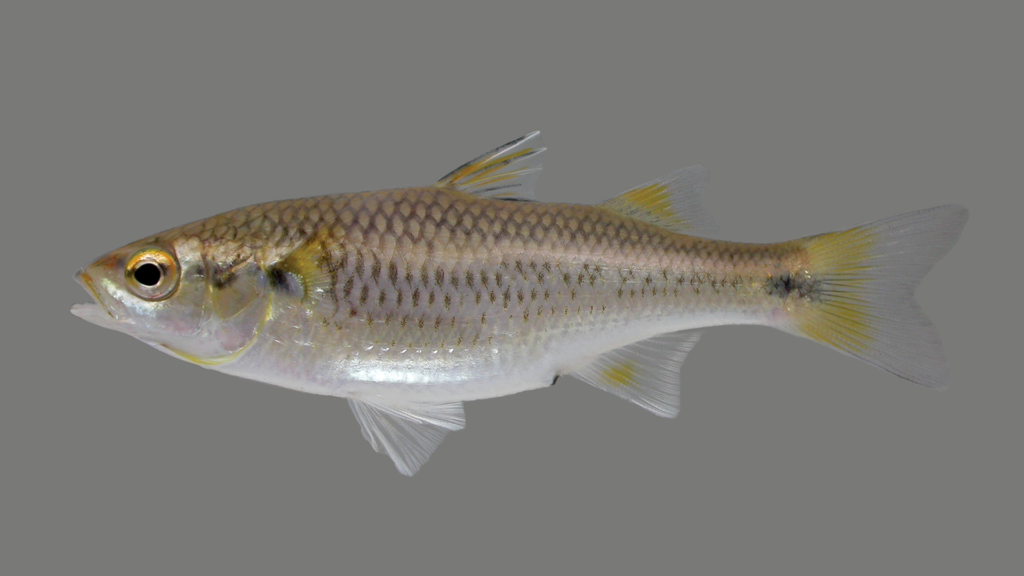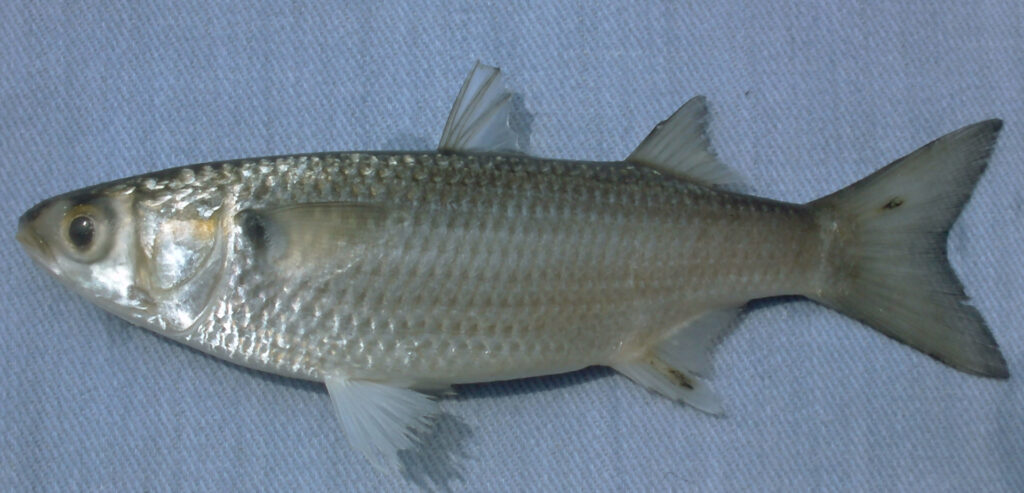By the NCFishes.com Team
North Carolina is home to three species of mullets: Mountain Mullet, Dajaus monticola, Striped Mullet, Mugil cephalus, and White Mullet, Mugil curema (Tracy et al. 2020; NCFishes.com). [Please note: Tracy et al. (2020) may be downloaded for free at: https://trace.tennessee.edu/sfcproceedings/vol1/iss60/1.] The family name, Mugilidae, is derived from the Latin, mugil, meaning Mullet, which in turn is probably derived from mulgeo, meaning suck (Boschung and Mayden 2004 as cited in Powers 2020).

Travelling in active schools in our coastal waters, one may hear mullets referred to as Finger Mullet when they are young adults because of their size and importance as a bait fish, Jumping Mullet because of their tendency to leap out of the water, Silver Mullet, Common Mullet, Black Mullet, Grey (Gray) Mullet, or Callifaver Mullet (https://www.fishbase.se/Summary/FamilySummary.php?ID=359). Another vernacular name for mullets that is sure to raise some eyebrows is “Turd Wrestlers”, which originates from the observations that mullets feed on plankton and detritus, which they extract (suck) from the bottom sediments or via coprophagy (Powers 2020). However, the American Fisheries Society-accepted common names are more socially and politically acceptable: Mountain Mullet, Striped Mullet, and White Mullet (Page et al. 2013) and each of their scientific (Latin) name actually means something (please refer to The Meanings of the Scientific Names of Mullets, page 7).
Our mullets range in size from about 356 mm Total Length (14 inches) for Mountain Mullet to about 915 mm (36 inches) for White Mullet to about 1220 mm (48 inches) for Striped Mullet (Kells and Carpenter 2011). All three species are or believed to be catadromous species meaning they live in fresh or estuarine waters, but spawn in the ocean. Mountain Mullet may also be amphidromous meaning they migrate between salt and fresh water, but the migrations are not directly related to spawning but related to some other activity such as feeding (Rohde et al. 2009).
Mountain Mullet is a rarely encountered species in North Carolina waters where it is a seasonal inhabitant of fresh water (Map 1). [Note: see Supplemental Maps 1-3, page 8, showing North Carolina’s 100 counties, 21 river basins, and 4 physiographic regions.]. It may, however, be more common in U.S. waters than is generally thought because it is difficult to capture with most collecting gear (Pezold and Edwards 1983 as cited in Tracy et al. 2020). Striped Mullet is a seasonal inhabitant in all Coastal Plain river basins and can be found as far upstream as near the Fall Zone near Rockingham (Yadkin basin), at Lillington on the mainstem Cape Fear River (Cape Fear basin), and at Raleigh (Neuse basin) (Map 2). White Mullet has been rarely found distant from brackish and saltwater coastal waters. Vouchered specimens at the North Carolina Museum of Natural Sciences document the species only as far upstream as the Neuse River at New Bern and in Northeast Creek near Jacksonville (Neuse and White Oak River basins, respectively).

As stated previously, mullets are able to convert phytoplankton and benthic organic matter into fish biomass. In turn mullets then become important prey items for piscivorous species such as flounders, Striped Bass, Bluefish, Spotted Seatrout, Red Drum, King Mackerel, Spanish Mackerel, and many other commercially and recreationally important species (Manooch 1984). None of the mullet species are state- or federally-listed species (NCAC 2017; NCNHP 2020; NCWRC 2017), but the recreational and commercial harvesting (take) of both the Striped Mullet and White Mullet are regulated by the North Carolina Division of Marine Fisheries (NCDMF 2020).
Their identification is “relatively” straight-forward. Key characteristics for their proper identification include the shape of the head, the presence or absence of an adipose eyelid and an axillary process at the base of the pectoral fin, extent of scalation of the second dorsal and anal fins, and body pigmentation.

If you have troubles with your identifications, just send us (https://ncfishes.com/contact/) an e-mail and include as many quality digital photographs as you can along with all the pertinent locality descriptors so that we will know from where the fish came.